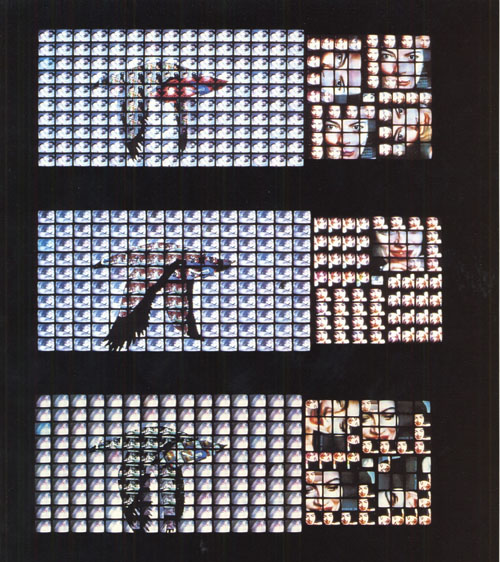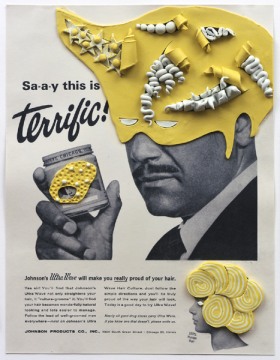
Nam June Paik
Korean-born artist Nam June Paik (1932-2006) was one of the most influential electronic artists of the latter half of the twentieth century. He began his career in the 1960s, utilizing televisions and his own broadcasts to create installations and sculptures with moving images and sound. Throughout his career, he has used a wide variety of electronic and digital media in addition to televisions, such as robots, satellites and lasers. Paik’s integration of these new forms of media into his works of art have introduced a new set of questions into the art world, including the range of acceptable physical media (which he set out to broaden), and the range of acceptable subject matter within such work. He has ultimately used electronics to ask questions about contemporary experience, our relationship to information presented on screens, and ideas about progression into the future that could only be explored through that specific media.
Paik’s use of televisions in a fine arts setting was initially an unexpected, even contradictory choice. Television was associated with low forms of art and entertainment, which appeared out of place in a high art gallery in the 1960s. Like many other “Postmodern”-era artists, Paik intended to use a media form that was familiar to the culture at large as a way of bridging “low” with “high” art. This choice allowed him to not only explore the expressive possibilities inherent in the dynamic source of imagery and sound, but to explore the statements and associations our culture has with television itself. Herein, he was able to confront ideas about mass media in a context that was relevant to and approachable by a wider audience. Part of this approachability might be attributable to the natural and cultural appeal of watching a television: the combination of moving images, bright lights, and sound draws the viewer in and engages him, especially when he is accustomed to watching a television in his everyday life. The looping imagery, nonsensical combination of image with sound, and repetition of form on a grid of screens is contrasted with the sort of sound, image and information that the viewer typically sees on a television. This adds a new dimension to the mere aesthetic experience of the sonic and visual compositions, allowing it to potentially become social commentary.
One of Paik’s appealing and enigmatic works is “Megatron/Matrix,” a 1995 work comprised of over 200 screens arranged in two connected rectangular grids. The larger grid, or “Megatron,” uses the images on its televisions to create larger images, such as pixilated figures, birds, and international flags. The title “Megatron” assumedly refers to the Transformers robot of the same name; the notion of individual televisions combining to create a larger image is metaphorically reflective of the Transformers mythology of smaller machines becoming larger, sentient robots. The televisions in the smaller grid, “Matrix,” repeat the same loop of images, often of faces. One of the screens is perpetually set to display clips from soft-core porn, showing sexualized women naked from the chest up. In combination, the two grids could be interpreted as the display of globally-reaching television (Megatron) and the experience of the viewer (Matrix). More generally, it could be interpreted as the embodiment of the attraction/aversion experience of mass media; the viewer is drawn in by the hypnotic looping of strange images and the enormity of the images, but he also pushes himself back from the confronting, semi-pornographic image in the center of Matrix.
Kac, Eduardo. “Satellite Art: An Interview with Nam June Paik.” DIVA -- Digital & Video Art Fair, 2005 Cologne (A Tribute to Nam June Paik), pp. 8-9. http://www.ekac.org/paik.interview.html
Hanhardt, John. “Nam June Paik.” Nam June Paik Studios. http://www.paikstudios.com/essay.html
http://americanart.si.edu/collections/search/artwork/?id=36486

Ellen Gallagher
Ellen Gallagher (1965-present) is a contemporary artist known for her focus upon social commentary through both minimalist and pictorial forms. Much of her work has concerned the appropriation of images from magazine ads, displaying them and modifying them to make larger social statements. A large part of her focus, of this magazine-based work and of her paintings, has been upon racial politics, especially of racial identity and appearance in mass media culture. As a black artist, Gallagher has been particularly concerned with concepts such as the historical portrayals of African-Americans, such as iconic minstrel show characters, and with the inclination of black women (and men) to assimilate their appearances and external lives to that of white America.
In her 2004-2005 work “De-Luxe,” Gallagher expands upon this latter idea of black appearance assimilation. She created a grid of images from 1960s-era magazines, most of which focused upon ads directed toward black women. The ads she selected urge the readers to bleach their skin, dye and style their hair, and get jobs like nursing, all of which would make them happier and more appealing. Beyond simply arranging these ads to emphasize their socio-political implications, Gallagher modified the ads by drawing, sculpting or adding other elements onto the faces in the ads. Many of her alterations involved covering the figures’ eyes, adding dramatically to their hair, or editing the text in the images down to a few choice words or random letters. A viewer could interpret these actions as an attempt to comment upon the loss of racial identity involved in these ads: the eyes, which are a major component of identity and personality have been obscured; the words have been rendered meaningless. It could also be an attempt to emphasize the “blackness” of appearance that the figures in the ads are trying to cover, particularly in the exaggeration of their hair. It is also essential to recognize the playfulness and absurdity of her choices to alter the ads. Gallagher, unlike many socially- and politically-engaged artists, incorporates a sense of humor into her work—placing white clay over a picture’s hair to create a strange hairpiece is a way of making the image ridiculous and innocuous, poking fun at the ad and the ideas it represents.
Stevens, Mark. “In Black and White.” New York Magazine Art Review website (2005). http://nymag.com/nymetro/arts/art/reviews/11058/
Latimer, Quinn. “Ellen Gallagher.” Art Info website (2009). http://www.artinfo.com/news/story/30340/ellen-gallagher/
“Ellen Gallagher.” profile on Art21 website. http://www.pbs.org/art21/artists/gallagher/
Enwezor, Okwui. “Ellen Gallager.” Frieze Magazine 28 (1996). http://www.frieze.com/issue/review/ellen_gallagher/

Additional Focus: Gregg Gillis
Gregg Gillis (1981-present) is a contemporary electronic musician and DJ who performs under the pseudonym “Girl Talk.” Gillis began mixing music as a hobby while he still worked as a biomedical engineer, and he eventually abandoned his career in engineering to focus on his career in music. Throughout the 2000’s, Gillis has produced mixes primarily in the hip-hop-centric genre of mash-ups, which involves sampling two or more songs to create a new track. Unlike most mash-up artists prior to him, Gillis produced feature-length albums of solid sampling, which blended hundreds of tracks from dozens of high-profile artists. Although Gillis has never officially faced a lawsuit for his work, the legality of his work has been questioned throughout his career.
His most popular albums, such as Night Ripper (2006), Feed the Animals (2008), and the most recent All Day (2010) have been simultaneously embraced as high-energy dance music and engaging social commentary. Gillis’ work combines a wide variety of music, ranging from Motown and soft rock to video game music to gangster rap and pop hip-hop. This variety, particularly in its unlikely combinations, has been considered a comment upon the media in American mass culture, emphasizing its similarity as well as its differences. Gillis explains his combination of tracks as an attempt to break the barriers of genre and to allow them to interact in unexpected ways. He uses different artists, particularly from different genres, more as different elements in a palate which could be combined into a tapestry of sonic textures and cultural associations.
“Interview: Girl Talk a/k/a Gregg Gillis.” The Village Voice (2008). http://blogs.villagevoice.com/music/2008/11/interview_girl.php
Walker, Rob. “Mash-Up Model.” The New York Times (2008). http://www.nytimes.com/2008/07/20/magazine/20wwln-consumed-t.html?_r=1&partner=rssnyt&emc=rss

Gillis performing live
Image courtesy of Wikipedia, http://en.wikipedia.org/wiki/File:Girl_Talk_and_dancing_girls.jpg
Girl Talk Sample:
"Bounce That"
from Night Ripper
Artist Research |
|---|
Tyne Lowe
|